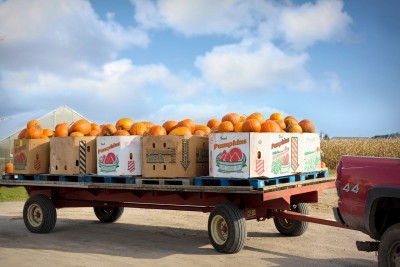Feeding Cull Pumpkins to Livestock

By Karla H. Jenkins, University of Nebraska-Lincoln Cow/Calf, Range Management, Panhandle Research and Extension Center
Cattle producers are always looking for ways to reduce feed costs for beef cattle production. One possibility is to use commodities that are available at salvage value. Purchasing commodities at salvage value can be a win/win situation for both the cattle producer and the owner of the commodity that is no longer worth its original value.
Pumpkins are a commodity having a limited window of optimal value. Depending on the year, many pumpkins may be left in the fields if not chosen for fall decorative purposes. Additionally, pumpkins harvested from the fields to be hauled to local markets may get broken or have some sort of blemish that makes the pumpkin less desirable for decorative purposes or human consumption. These pumpkins may be available for grazing or for inclusion in beef cattle rations.
Cattle find pumpkins palatable and do not seem to have much trouble consuming pumpkins left in the fields once the pumpkins have undergone some freezing and thawing. Pumpkins can also be lightly disked to facilitate consumption if they are still too firm for breaking up.
Pumpkins are high in moisture content (83-88%) and therefore do not provide a lot of dry matter per acre for cattle to consume. Grazing pumpkins in conjunction with a cornstalk residue field or a grass pasture or with supplemental hay may be necessary to ensure enough feed is available for the cattle. However, pumpkins make a good supplemental protein and energy source. The crude protein content tends to be between 14-17% on a dry matter basis and the in vitro digestibility (similar to total digestible nutrients or TDN) is 60-70%. Pumpkins can make a good supplemental feed for dry pregnant cows in the fall or can be included as a component of a growing ration for calves.
Regardless of the commodity being considered, producers need to evaluate the cost of the commodity per unit of protein or energy provided and include any transportation and labor costs associated with acquiring and feeding the commodity.
Utilizing alternative commodities no longer at peak market value can be a win for the cattle, a win for the cattle producer, and a win for the commodity owner.
Upcoming Events
WEBINAR - Automated Milking Systems Efficiency: Balancing Focus on Individual Cows and System Optimization
May 8, 2024
Please join Cornell the SWNY team and MSU Extension for our talk with Dr. Pablo Silva Boloña on improving efficiency of Automated milking systems by focusing on milking settings for individual and group success.
Broiler Field Day at Sunny Cove Farm
June 6, 2024
Alfred Station, NY
Join us for a field day to explore broiler production, processing, and finances. Meghan Snyder of Sunny Cove Farm will be our host. She raises small batches of organic broilers, processing them on-farm under the 1,000 bird exemption.
Stockmanship and Stewardship 2024
October 25, 2024
Hamburg, NY
Save the date!! The event is one of 4 across the US and is a two-day educational experience featuring low-stress cattle handling demonstrations, Beef Quality Assurance educational sessions, facility design sessions, and industry updates.
Announcements
No announcements at this time.





